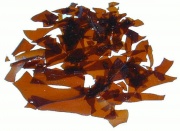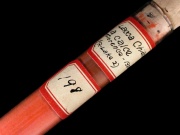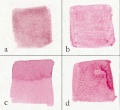Difference between revisions of "Lac dye"
(username removed) |
|||
| Line 2: | Line 2: | ||
== Description == | == Description == | ||
| − | A deep red colorant extracted from the crude [ | + | A deep red colorant extracted from the crude [[shellac]] resin excreted by the lac insect, ''Laccifer (Tachardia) lacca'' (formerly ''Coccus lacca''), indigenous to southeast Asia. The lac insect is most often found on banyan trees (''Ficus benghalensis'', or ''F. indica'') and on juniper trees (''Rhamnus jujuba''). Lac dye is a byproduct produced during the shellac purification process. Its primary colorant is laccaic acid (C20H14O11). Lac dye was an important dyestuff used since ancient times. The bright red colorant gave a lightfast tint to [[silk]] and [[wool]]. It is similar in color to dyes obtained from [[cochineal]] and [[kermes]]. Lac dye was also precipitated with [[alumina trihydrate]] to make Indian lake pigment. Now synthetic colorants have replaced the use of lac dye. |
[[File:198 lacca chiara a calce.jpg|thumb|Lac dye]] | [[File:198 lacca chiara a calce.jpg|thumb|Lac dye]] | ||
| + | |||
== Synonyms and Related Terms == | == Synonyms and Related Terms == | ||
Revision as of 10:15, 21 January 2014
Description
A deep red colorant extracted from the crude Shellac resin excreted by the lac insect, Laccifer (Tachardia) lacca (formerly Coccus lacca), indigenous to southeast Asia. The lac insect is most often found on banyan trees (Ficus benghalensis, or F. indica) and on juniper trees (Rhamnus jujuba). Lac dye is a byproduct produced during the shellac purification process. Its primary colorant is laccaic acid (C20H14O11). Lac dye was an important dyestuff used since ancient times. The bright red colorant gave a lightfast tint to Silk and Wool. It is similar in color to dyes obtained from Cochineal and Kermes. Lac dye was also precipitated with Alumina trihydrate to make Indian lake pigment. Now synthetic colorants have replaced the use of lac dye.
Synonyms and Related Terms
lac lake; lac colorant; Natural Red 25; CI 75450; laccaic acid; gomme laque (Fr.); lic-lac (Deut.); laca (Esp., Port.); tinta laca (Esp.); Indiki lakka (Gr.); lacca (It.); lac-lac (Ned.); lakka (Fin.); na ros (Tibetan); gummilack; caked lac; grained lac; kadi lakh; seed-lac; rangbatti; stick lac; Indian lake; lac-dye; lacchaic acid; lac day;
Other Properties
Laccaic acid is soluble in methanol (dries to form needle-like crystals).
Additional Information
° J.Hofenk-de Graaf, Natural Dyestuffs: Origin, Chemical Constitution, Identification Central Research Laboratory for Objects of Art and Science, Amsterdam, September 1969.
Additional Images
Authority
- Encyclopedia Britannica, http://www.britannica.com Comment: "Lac." Encyclopædia Britannica. 15 Mar. 2004 . Insect = laccifer lacca
- The Dictionary of Art, Grove's Dictionaries Inc., New York, 1996 Comment: "Pigments" gives insect as Kerria lacca, which lives on fig trees in India and East Asia
- R. J. Gettens, G.L. Stout, Painting Materials, A Short Encyclopaedia, Dover Publications, New York, 1966 Comment: Insect - Coccus lacca
- Judith Hofenk-de Graaff, Natural Dyestuffs: Origin, Chemical Constitution, Identification, Central Research Laboratory for Objects of Art and Science, Amsterdam, 1969
- J. Thornton, 'The Use of Dyes and Colored Varnishes in Wood Polychromy', Painted Wood: History and Conservation, The Getty Conservation Insitute, Los Angeles, 1998
- Thomas Gregory, The Condensed Chemical Dictionary, Reinhold Publishing, New York, 3rd ed., 1942
- Matt Roberts, Don Etherington, Bookbinding and the Conservation of Books: a Dictionary of Descriptive Terminology, U.S. Government Printing Office, Washington DC, 1982
- F. Crace-Calvert, Dyeing and Calico Printing, Palmer & Howe, London, 1876
- Thomas B. Brill, Light Its Interaction with Art and Antiquities, Plenum Press, New York City, 1980
- Art and Architecture Thesaurus Online, http://www.getty.edu/research/tools/vocabulary/aat/, J. Paul Getty Trust, Los Angeles, 2000
- Website address 1 Comment: http://www.coloria.net/varita.htm - Finnish name


